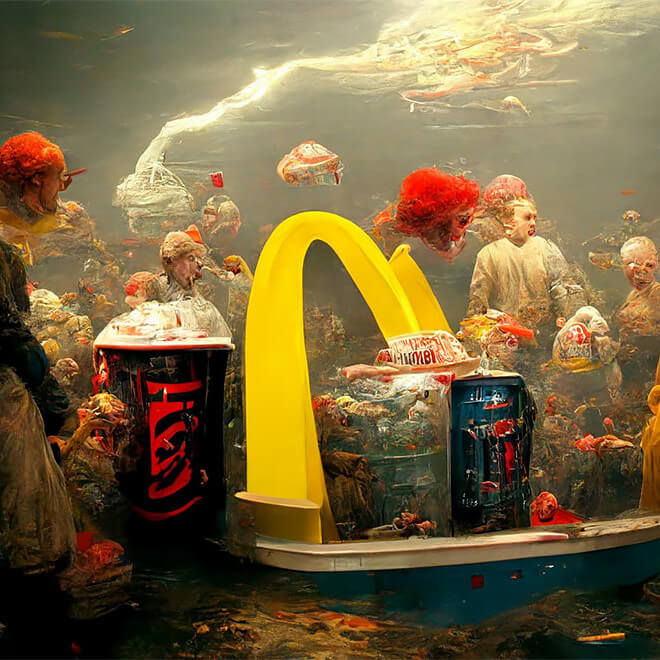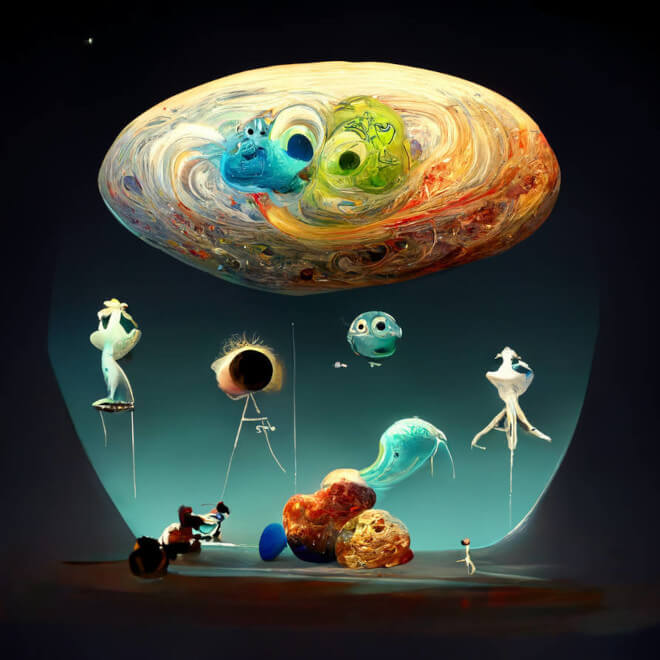Is AI-generated art a kind of generative art? Is it art at all? From the perspective of someone practising generative art, here are my thoughts.
Quick Links
The Wave
If you’re either a producer or consumer of generative art (or both) and like to browse #generativeart-tagged content on social media, you might have noticed a shift in this content from about early 2022 onwards. A new wave of ‘AI artists’ began to flood the internet, releasing a deluge of AI-generated images produced via text prompts with programs such as Stable Diffusion, Dall-e and Midjourney, eventually prompting protests within the art industry itself.
The imagery produced by these programs can often be fascinating and of uncanny (valley?) quality. But is this new art – if we’re happy to call it that – a species of generative art, or is it something else?


The Similarities
If we’re to compare the two, I need to clarify what I mean by generative art in the first place.
Some definitions of generative art only require that the art in question is created in whole or in part by an autonomous system, in which case AI-generated art would be a kind of generative art. My own understanding of generative art (shared by many other practitioners in the field) is more in line with what you might think of as ‘creative coding’. Specifically, I would define generative art as an artform where code is used as the creative medium, and the process is (to a greater or lesser extent) stochastic in nature (i.e. each piece might lead to countless variations, none of which are fully determined in advance).
Using this definition, certain similarities between generative art and AI art are hard to deny:
- The images produced in both cases are generated by algorithms.
- The process is often iterative (i.e. resulting in many iterations or variations).
- There is creativity involved (though the degree to which this is the case certainly differs).
- The program or algorithm can be seen to act in an autonomous manner.
- The output is often curated (i.e. keep the best, kill the rest).
The Differences
So much for the similarities. As for the differences, these required a little more elaboration to get my own thinking clear on the subject. I found it helpful to think of the differences between generative art and AI text-to-image tools in terms of craft, creativity, knowledge, skill and style.
- Craft: Generative art requires learning a craft. In this case, the craft of coding as an expressive medium. You don’t learn to code overnight; becoming a competent coder can take years. In contrast, using an AI tool like Midjourney does not require anything analogous to learning a craft. Now, it could be argued that a certain patience and ingenuity is required in order to ‘craft’ the results one is after, and sure – I’ll concede that. But this is also true of clever google searching.
- Creativity: The are no doubt many very imaginative and poetically-inspired text prompts responsible for a large swathe of AI artistic output. However, the creativity involved is limited to the lexical domain and is completely detached from the actual artistic process. The latter is very much a ‘black box’ as far as the user is concerned. In contrast, the creativity required of the generative artist is very involved and can often be quite intellectually taxing.
- Knowledge: Sometimes with generative art, the results are hard or even impossible to predict (and this is part of the fun). However, you are nonetheless knowledgeable of the underlying process, i.e. the code you’ve pored over to get to this point. With AI art, unless you’re responsible for writing the software itself, there is no real insight into the underlying process; hundreds of thousands of images might have been processed (in many cases outright stolen) to produce the end result, but you’ll be none the wiser. In fact many of these images may be the culmination of painting techniques perfected over hundreds of years of artistic ingenuity.
- Skill: This is related to the repeated practise of a craft, and is something conspicuously absent from AI art. For example, the user doesn’t need to develop any skills related to the use of line, texture, tone, colour or composition. For generative artists, these skills are not only vital, but a large part of the why of artistic expression. If we didn’t get to play with this stuff, what would be the point?
- Style: With the combination of the above – craft, creativity, knowledge and skill – eventually a unique style (or series of styles) will emerge that characterises an artist’s work. With AI art, you’ll no doubt see style aplenty, but none of it is developed by the user. It is rather an imprint of the program itself and how it processes its enormous repository of source content.
The Verdict
At the very least, it’s misleading to class AI text-to-image art as a kind of generative art. There is a considerable gulf between the two practices, and I would even argue that there are serious issues with labelling it as art at all.
Here’s the real problem, as I see it: AI art is essentially a kind of outsourcing of our inner lives as artists. It automates the active process of creating (the ‘journey’ we might say)*, and of developing artistic insight, skill and understanding. This is the lifeblood of art, and while AI text-to-image tools can certainly be fun to play with and could act as valuable sources of inspiration, as an end in themselves they’re actually quite parasitic to the artistic process, relegating us to relatively passive observers. Is that where we want generative art to go, or art in general?
Computer says no. 🙂
* Take note Midjourney developers.
Typical. This sort of art is new. We don’t know much about it, though I can certainly say we could be on the brink of developing art for something that might be important for people who don’t think so now, though perhaps sometime into the future that replaces “plastic surgery”, because when we last had updates on plastic surgery perhaps this art might have assisted with developing some sort of reference point in the research and development phases, grafting and matching tones, muscular contour, etc.
This post is about how coding generative art compares with writing text prompts into generative AI image software, and isn’t intended as a tear-down of generative AI more widely. You seem to be talking about how generative AI might be used in a medical setting, which is certainly interesting, but I’m not sure how it relates to this discussion.